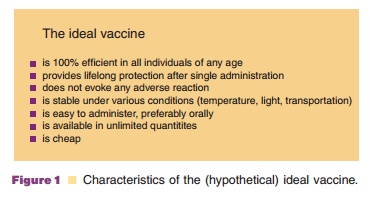Chapter: Pharmaceutical Biotechnology: Fundamentals and Applications : Vaccines
Vaccines
INTRODUCTION
Traditionally, vaccination aims to prevent infectious diseases. It can
be considered as one of the most successful medical strategies. The
conventional vaccines routinely applied in man are very effective in
preventing a number of infectious diseases. This is illustrated by the fact
that mass vaccination has resulted in the worldwide eradication of smallpox in
the 1970s. Moreover, diphtheria, tetanus, poliomyeli-tis, measles, mumps, and
rubella are under control in the developed countries as well as in an
increasing number of developing countries, because of the application of
childhood vaccines. Currently, vaccines are not only developed against
infectious diseases. Vaccines in the pipeline include anti-drug abuse vaccines
(nicotine, cocaine) and vaccines against allergies, cancer and Alzheimer’s
disease.
In the rapidly evolving field of new vaccine technologies one can
discern the improvement of existing vaccines and the development of vaccines
for diseases against which no vaccine is available yet. Modern biotechnology
has an enormous impact on current vaccine development. The elucidation of the
molecular structures of pathogens and the tremendous progress made in
immunology during the past few decades have led to the identification of
protective antigens and ways to deliver them. Together with technological
advances, this has caused a move from empirical vaccine development to more
rational approaches. A major goal of modern vaccine technology is to fulfill
all requirements of the ideal vaccine as summarized in Figure 1, by expressing antigen
epitopes (¼ the smallest molecular structures recognized by the immune system)
and/or isolating those antigens that confer an effective immune response, and
eliminating structures that cause deleterious effects. Thus, “cleaner,”
well-defined products can be obtained, resulting in improved safety. In
addition, modern methodologies may provide simpler production processes for
selected vaccine components.
In the following section immunological princi-ples that are important
for vaccine design are summarized. Subsequently, conventional vaccines, which
are not a result of modern genetic or chemical engineering technologies will be
addressed. Conventional and modern vaccines are listed in Table 1. Current
strategies used in the development and manufacture of new vaccines are
discussed in the section “Modern vaccine technologies”. It is not our intent to
provide a comprehensive review of all possible vaccine options for all possible
diseases. Rather, we will explain modern approaches to vaccine development and
illustrate these approaches with representative examples. In the last section
pharma-ceutical aspects of vaccines are dealt with.

Related Topics